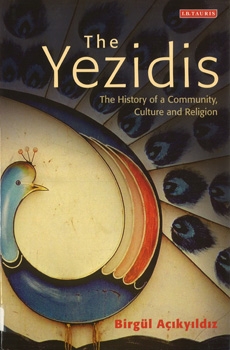|
ACKNOWLEDGEMENTS
The origins of this book lie substantially in my Ph.D. thesis completed in the Institute of Art and Archaeology at the University of Paris I Pantheon-Sorbonne in October 2006. The composition of this book has been realised with the help and advice of many people, but nobody is responsible for its errors and weakness except myself. My thanks are particularly due to Professor Alastair Northedge, who supervised the original thesis. I am grateful to Professor Jeremy Johns who supported this work with his precious criticisms and to Dr. Mamo Farhan Othman who supplied me with a great deal of information on Tezidi history and culture. 1 would also like to thank Prof. Dr. Asker Kartan, Associate Professor Christine Allison and Dr. Pierre Simon for their contribution.
Acknowledgements are also due to the Barakat Trust, the National Higher Education and Research Ministry ot fiance, and the Shivan Perwer International Cultural Foundation for their generous financial support. I would like to express my gratitude to the Kurdish Institute ot Paris for its support during my doctoral studies in Paris, to the Cultural Centre ot Lalish in Dohuk, Ba’shiqe and Sinjar for their assistance in my fieldwork, and to the Khalili Research Centre of Oxford University and the Department ot Communication Sciences of Hacettepe University for providing me with facilities necessary for the redaction of this book.
The translation and transcription ot the inscriptions were carried out by Dr. Luai Jaff, Muhammad Hussein, and Zeinab Zaza. The latter also helped me with the translation of the Arabic sources. The translation ot the Ottoman archives was made in collaboration with Yavuz Aykan. Natalia Tari, Paul Grey and Arezou Azad helped me with corrections in the English texts. Arzu Karahan helped me to give the final shape to the line drawings. I thank them greatly.
Amongst the Yezidis, my thanks go to Mir Kamuran Beg, Khidir Dimili, Kheyri Bozan, Suleiman Havend, Heci Katari, Heci Ali Suleiman, Ismail Hasan Said, Khidir Kh. Behzani, Sozan Hajee Samw, Sagvan Mirad, Said Kasim Hason, Dexil Kasim Hason, Karina Usabian, Feqir Tayar Keleshi, Torina Torin, Kibar, Rustem and Siyabend Hudeda for their support. Moreover, I would like to thank the people who helped me in organising transport and accommodation as well as in establishing contacts during my fieldwork. In particular, I would like to thank the many local residents who welcomed me generously as a guest and guided me during my research. These include Devrim Karaoba, Huda, Macid, and Zubeida Berwari, and Shehnaz Zebari in Dohuk, the family of Pir§eng Budak in Diyarbakir, the family of Fatma Akdogan in Midyat and Nusaybin, family of Ozcan Ayboga in Tunceli, and M. Ali Hanger and Eyiip Bur<; in Viran§ehir, Dr. Vardan Vaskanian and §ilan Aras in Yerevan, Ibrahim Bilal, Hamide and Said Bilal in Afrin and Zekeria Mustafa in Damascus. I thank Dr. Saywan Barzani, who facilitated my trips in northern Iraq.
Finally, I would like to thank my family and Marlyse Lescot, who supported me throughout this work.
Introduction
The Yezidis are a fascinating people who form part of the rich cultural mosaic of the Middle East. They first appeared on the historical scene as an isolated community in the Kurdish mountains of northern Iraq in the twelfth century. Originally the heirs to a variety of cultural and religious beliefs, including Zoroastrianism, they became the supporters and followers of the Sufi Sheikh ‘Adi. Thus, a syncretic belief system and unique religious belief system grew up. Eventually, the Yezidis acquired the label of‘devil-worshippers’ for their love of the Peacock Angel.
This book aims to give a comprehensive and comprehensible introduction to Yezidi culture, religion and society. It examines Yezidism not only as a religion but also as a historical and social phenomenon. This is a fresh approach to the subject. Previous scholars focused mainly on the origins, early history and religious practices of the modern Yezidis of northern Iraq.' In this book, the full historical and geographic range of Yezidism is examined for the first time, not just in northern Iraq but also in Turkey, Syria and Transcaucasia. Thus, the book throws light on the origins of Yezidism and documents its historical development as part of the general history of the Kurds. It traces the changing fortunes of Yezidism and examines the role of the Yezidis in Kurdish history over time and in the different Kurdish regions.2 The Yezidi community emerged in a small area, known as Sheikhan, and spread rapidly amongst the Kurdish tribes. However, this rapid expansion disturbed their Muslim neighbours, and from the thirteenth century onwards, Yezidis suffered repression and massacre. As a result, the Yezidis remain a small, oppressed community, but one that has stubbornly survived to this day.
This book explores what makes Yezidism a separate and unique religion. It principally focuses on the Peacock Angel (Tawusi Melek), the main character in Yezidism, and explores his relation with the Creator and the Yezidi people. Yezidis believe in one eternal God (Xwedc) who is the creator of the universe. He is Good and …
|
